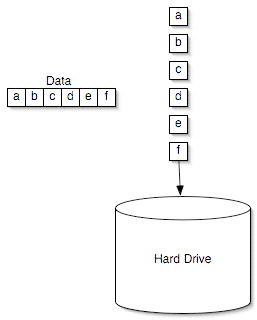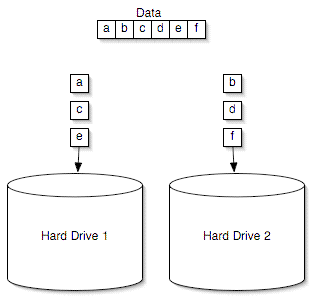Western Digital's Raptors in RAID-0: Are two drives better than one?
by Anand Lal Shimpi on July 1, 2004 12:00 PM EST- Posted in
- Storage
Doubling Theoretical Performance: RAID-0
For those of you who are already familiar with RAID and how it works, go ahead and skip to the benchmarks; these next two pages are designed to serve as brief introductions to the two most common forms of RAID on the desktop: RAID-0 and RAID-1.Otherwise known as striping, RAID-0 is the only performance-enhancing form of RAID that we'll be talking about in this article. The premise behind striping is simple. Data being written to a drive is split into "stripes", generally 16 - 256KB in size, with each stripe being written to a different drive in the array. For example, say we were dealing with a 2-drive RAID-0 array with a stripe size of 128KB and we wanted to write 256KB of data; drive 0 would get the first 128KB of data written to it, and drive 1 would get the remaining 128KB.

Writing to a single hard disk

Writing to a two-disk RAID-0 array
Here, you can see that the write performance of RAID-0 can be almost double that of a single drive, since twice as much data gets written at the same time. The higher write performance is obtained at the expense of some controller overhead, since the RAID controller has to handle splitting up data into stripes before sending it to the drives themselves - but with modern day microprocessors being as fast as they are, the overhead is usually thought of as negligible.
Reading works the exact same way, but in reverse. Say that we want to read that same 256KB of data back; we pull one stripe from drive 0 and the other stripe from drive 1. The read is now completed in half the time, theoretically doubling performance.
We are careful to use the word "theoretical" because the performance advantages of RAID-0 disappear quickly if we're not dealing in ideal situations like the ones we just described. If too large of a stripe size is used, then the performance advantages of RAID-0 can be lost, while too small of a stripe size could result in excess overhead, reducing the performance improvement of the striped array.
We have seen in the past that for most desktop applications, the largest stripe size that a desktop RAID controller will offer is usually the best choice for performance. With Intel's ICH5/6, that translates into a 128KB stripe size, which for our comparison is what we decided to go with. The other stripe size options didn't offer any better performance for our desktop test suite.
The main downside to RAID-0, other than cost, is reliability. The size of a RAID-0 array is the sum of all of its members; so, two 100GB drives in a RAID-0 array will give you one array with a 200GB total capacity. Unfortunately, if you lose any one of the drives in the array, all of your data is lost and isn't recoverable. Since two drives are working in tandem and are both necessary to hold your data, you effectively halve the mean time between failure by moving to a two-drive RAID-0 array.










127 Comments
View All Comments
RDMustang1 - Thursday, July 1, 2004 - link
AMDScooter is right on. Onboard RAID (and most cheap raid cards such as Promise) are technically software RAID cards and usually do not offer any speed increases over 5%. True hardware RAID cards offer speed increases at about 40% (as shown in the past). This varies of course with the implementation but on average hardware RAID has been shown to increase performance much more than these cheap RAID impelementations. Regs needs to look into what he's talking about more because performance advantages are not lost in advertising.pio!pio! - Thursday, July 1, 2004 - link
I do a some video editing and I'm wondering the performance gain of say reading a a 4GB file and writing directly writing it again (ie a copy) in a RAID or non raid configuration. I'm using a single HDD right now, but I'm thinking of going to 2 HDD and read from one HDD and copy to the other..but I'm wondering if a RAID configuration will offer similar advantages?mkruer - Thursday, July 1, 2004 - link
I am building my self a new system this year, and I am seriously thinking of getting 2x250 Western Digital Caviars (SATA) and making them into a RAID 1, for redundancy purposes. I already knew that RAID 0 offers little real world improvements, but I would like to see how it compares to RAID 0 and just a single drive. I have never under stood why you bother comparing 8 normal drive, and one of them in RAID 0.Why not rerun the tests with just a single type of drive, one standard (stand alone), one RAID 0 and one RAID 1. All things being equal this should give a better indication of just how well any drives should do in the following configurations, using that RAID chip. (Yes there will be some small differences, but the should end up being negligible)
I would recommend choosing your favorite three drives, and doing a comparison of each RAID version on that.
eastvillager - Thursday, July 1, 2004 - link
Ok, you kind of lost me when you didn't install the Intel Application Accelerator...AMDScooter - Thursday, July 1, 2004 - link
I hope this does not come off as a bash as the review was informative to some extent, but I feel it is lacking in several areas. Why bother to waste space describing in detail the differences between RAID 1 & 0 if no benchmarks from a RAID 1 are going to be included in the article?? And as mentioned earlier, using only a single onboard RAID soloution has some merit for parity in benchmarking but is hardly definitive. This would have been a more well rounded review just by adding adding some RAID 1 benchmarks along with benchmarks from different RAID IDE/SATA controllers AND the differences in CPU utilization between them. Most of the onboard soloutions are actually SOFTWARE RAID's as compared to a true dedicated hardware device. It would also have been nice to see some SCSI RAID benchies tossed in the mix. SATA drives are almost in the same price as entry level 15k rpm SCSI U320 drives. While SCSI RAID is not on any normal desktop MOBO's, many users purchase seperate RAID cards anyway. I use 2 Seagate 15k.3's in RAID0 on a Adaptec 39320 Host RAID device. It sure feels faster than a single drive to me ;)MrMoo - Thursday, July 1, 2004 - link
This article and previous raid related ones ive read here have all seemed to be opposite of results ive seen with my setup. I have a Promise TX2000 raid controller and four IBM/Hitachi 180GB 7200rpm drives.Originally i only had one of the hitachis and when i went to a 2 drive raid 0 the perfomance increase was definitely noticeable. I wont bother repeating any benchmarks i have of it because i dont feel they really tell anything, nor do i still have ay records of them. But most places i could see noticeable improvements were in application loads, game loads and most signicantly when windows would boot up, especially once the windows install had become old and lots of apps were all trying to load at the same time.
Then last fall i purchased another 2 hitachi drives and decided to test out a 4 disk raid 0 Now did that thing fly, application loads were almost instantanious for all but the largest programs. and my performance was limited almost entirely by the PCI bus (oh how i hate thee) as i was acheiving average transfer rates of 120 MB/s as reported by sandra and HdTach.
Then recently (yesterday to be exact) I purchased 2 SATA Hitachi 250GB drives and i hooked them up as raid 0 on my onboard sata raid controller (a Silicon Image 3112 controller on my Albatron KX18D) here i would acheive about 65 MB/s transfer rates. this seems on par with was i would expect, but then i notice that cpu usage with the sata raid was around 55% and it was only about 5% with the promise IDE raid.
Even though the average transfer rate of the new array are greater than one drive, performance with programs running off of it dont seem any faster than a single drive.
My only thought is whether these onboard raid solutions use up so much overheard that the performance increase is negligable. all my experience with them seems to say raid 0 on them is useless, but raid 0 on a dedicated controller seems to increase performance drastically.
Regs - Thursday, July 1, 2004 - link
*what*Regs - Thursday, July 1, 2004 - link
I doubt a better raid card will offer any more performance. Maybe another 1-2%. 2% is was seperates quality these days in advertising.ep0ch - Thursday, July 1, 2004 - link
I usually like your articles Anand. But the one really fundamental thing wrong with the whole comparison is that you didn't actually compare RAID0 with a decent RAID 0 card like HighPoint RocketRAID.Insomniac - Thursday, July 1, 2004 - link
I just realized performance is only as fast as the slowest drive. So pairing a Raptor up with a cheap 80 GB drive is a waste.